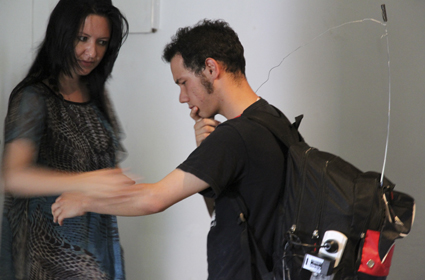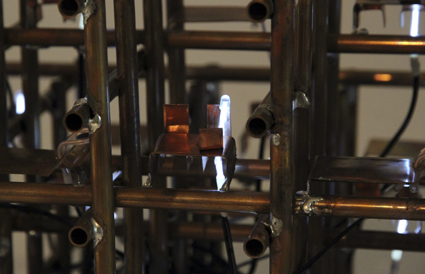aligning senses and ethics
somaya langley: sydney dorkbot group show

Human Theramin, Luke Pasquale Calarco and audience member
photo Pia van Gelder
Human Theramin, Luke Pasquale Calarco and audience member
AS IF HANDPICKED ESPECIALLY TO APPEAL TO MY SENSES AND ALIGN WITH MY ETHICS, THIS YEAR’S SYDNEY DORKBOT GROUP SHOW EXHIBITION AT SERIAL SPACE ASSEMBLED SIX CAPTIVATINGLY EARNEST WORKS. CURATOR PIA VAN GELDER ALSO HOSTED AN ARTISTS’ TALK THAT TURNED OUT TO BE A PRETTY SPECIAL SUNDAY AFTERNOON OF ENGAGING DISCUSSION.
Jiann Hughes’ interactive boxing breath-centric work, Below the Belt, is right up my alley: sensors, interactivity and an awesome costume to boot. Donning the red headgear, I’m strapped into an immersive solitary auditory environment that immediately blocks out the reverberant gallery sound. Appearing on screen, Tony (the boxing instructor from Mundine’s gym) puts me to the test. He’s only interested in one thing: my breathing. In a series of rounds, he manages to coach me through a couple of breathing exercises while dishing out occasional words of criticism or encouragement. Ability to control breath leaves you with a ranking of lightweight, featherweight or sometimes even better.

Below the Belt, Jiann Hughes
photo Pia van Gelder
Below the Belt, Jiann Hughes
So often breath-controlled interactives encourage peaceful experiences (such as the artworks of George Khut, Hannah Clemen or Elliat Rich). Below the Belt takes you into another realm of all-consuming fun reminiscent of You Are Here’s Pemulwuy Dream Team interactive boxing game, albeit with a very different motive. As Hughes puts it, the work explores “tensions between competitive contact sports and the inward focus of breathing practices that support[s] them.” Amid the fun, I am still consciously attempting to centre myself through my breath. Overall, Below the Belt could do with a little tidying at the edges. However building a work like this is challenging—especially in incorporating this form of interactive control—while ensuring the scenario is a truly believable one. Not for one moment was my attention distracted.
Next on offer is a different intimate interaction. The Human Theramin by Luke Pasquale Calarco is a construction made from a backpack stuffed with the essential old-school gadgets, aerial poking out the top, plus a power lead trailing behind. Wearing the backpack, Calarco turns himself into a touchable sound-producing instrument, generating a range of squeaks, squeals, drones and groans typical of a short-circuiting electronic gadget. Having navigated all the politics of physical interaction with a total stranger, audience members’ faces display a sense of wonder as they engage in the noise-making process. Observing from the sidelines, it’s like watching a bunch of two-year-olds with a newfound toy.

Drone 1, David Kirkpatrick
photo Pia van Gelder
Drone 1, David Kirkpatrick
David Kirkpatrick’s Drone 1, bearing several crucial messages, is a reflection of the state of current society. One oversized switch swaps the glow of a dozen or so tiny protrusions of electro-luminescent wire to radiating loops, positioned equidistantly in a 3D copper pipe grid. Look closer and you realise it is an apartment block in miniature—each room either an office (containing a desk, chairs and laptop) or a bedroom. At the flick of the switch, stick figures hard at work in their offices then lie still in their beds. Kirkpatrick describes Drone 1 as “the way we feel when moving towards a binary life,” and it’s almost impossible to oppose this statement. Which of us doesn’t feel chained to a computer almost every waking hour, with our only respite being sleep? Through further explanation in the artist’s talk, more layers of critique appear. “Copper is important to tell this story,” states Kirkpatrick. Constructed from finite resources, the materials he’s selected also draw attention to our way of life that is ultimately unsustainable in so many respects.
The other three works in this show are non-interactive and it’s worthwhile noting comments from the curator. She explains that visitors to the exhibition expect the works to be responsive. When nothing happens, they’re actually surprised.
The first of these is Michael Petchovsky’s Infomadream, which is a step towards socially, environmentally and economically conscious media art creation. For several years, I’ve been concerned about the immeasurable environmental impact of electronic components used in creating technology-based artworks. Infomadream is a gesture in the direction of overall awareness. This video installation utilises an open source operating system and video tools installed on some hard garbage (a laptop found on the side of the street). While the video wasn’t the most engaging work in the show, the ideas—particularly the desire for positive activism, which it helped to generate during discussion—sparked something far greater than the work itself.
Ross Manning’s Trapped Universe is the odd one out. Located in the main exhibition space, it deserved to be placed where quiet contemplation might occur. Without an interactive or time-based component, this work actually requires more patience of its audience. While it may have been overlooked on occasion, for those who were willing to sit and observe this undemanding work gently revealed an entire world of peaks, valleys and cascading rainbows.

Death by Stereo, Wade Marynowsky
photo Pia van Gelder
Death by Stereo, Wade Marynowsky
Death by Stereo combines all of the elements one would expect to find in a Wade Marynowsky work, coupled with the essential Marynowsky aesthetic: retro devices, bubbling pink foam and the almost overbearing chords of impending doom—as if you’d been suddenly transported into a 1950s sci-fi horror flick. This work is the least understated of the exhibition, and I imagine that’s its purpose. As Marynowsky indicates, Death by Stereo “comments on the way we receive constant tragic news bursts.” I’m not so sure this is the message I receive. But it does imprint on my mind that anything pink and bubbly must certainly be toxic and I should remember to steer clear in the future.
I’m revitalised by the works in this exhibition, particularly the ideas driving them and so evident in the accompanying artists’ talks and subsequent discussions that were nothing short of invigorating. I can almost glimpse a new era of media art creation that is socially, politically, economically and environmentally conscious. A new generation and decade of art-making, considerate of the resources consumed in its construction and presentation, produces a glimmer of hope.
Sydney Dorkbot 2011 Group Show, curator Pia van Gelder, Serial Space, Sydney, Feb 22-27; http://dorkbotsyd.boztek.net
RealTime issue #102 April-May 2011 pg. 29






